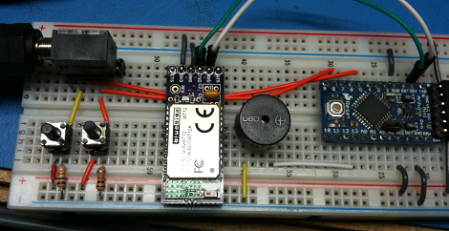The team a Zunkworks wanted to build a device for people who can’t normally use a keyboard and mouse. The Bluetooth Morse code keyboard is what they came up with. This build gives the user full control over the keyboard and mouse using a single button or a sip & puff interface.
The project is build around an Arduino ProMini, an FTDI breakout board, and a Bluetooth module. It’s a fairly simple build, but the meat of the project lies in the code. Every keystroke and mouse movement is only a few button presses away.
Like the USB Morse code keyboard we saw last year, this project also translates the dits and dahs into characters that are available on a keyboard. In fact, Zunkworks even used the code for this USB morse keyboard as a reference. With only one button for user input, we’re reminded of Stephen Hawking’s computer interface. This project might be an improvement on Hawking’s system because it allows control of the mouse cursor.
Check out the video of the Morse keyboard below.
[youtube=http://www.youtube.com/watch?v=2mTEevUbbUU&w=470]
















how does it know when one letter ends and another begins?
I’d assume the length of the time between entries is timed. Too long of a wait, it would figure it was time for the next letter.
That’s just a guess.
That’s silly though, you are limited in how fast you can type by the timeout. And you can’t wait too long or you will get the wrong letter.
This could all be fixed with a “next” button that says when you are done typing letters
That’s the usual way that Morse works: gaps between letters; bigger gaps between words. Text entry on many mobile phones uses a similar method to select letters: press the button ’till you get the wanted letter, then wait a moment to accept it. It limits speed in either case; but that doesn’t stop telegraphers and SMSers from achieving very impressive speeds.
Why when there are a million other systems that allow you to type punctuation and other symbols that are not in Morse code.
Many accessability systems tried to do this and failed.
Because there are countless people who (like Mr Zunker, here) already have telegraphy skills. There’s no good reason for them to learn a new system. ☺
I’m not going to hold you to the 1M figure, but in general terms are there are that many other systems that will allow data entry with only one momentary switch? That simple input device is what make accessibility devices that Morse code so adaptable to the varied range of abilities that the disabled have. I think it would be interesting to be able to view a listing of accessibility devices that used Morse code along with analysis of why those worked, worked, along with why those failed, failed.
Actually, it seems like there is two buttons for user input. Of course, I am not really sure why there would be a need for two buttons.
Also, Hawking’s interface already has mouse control implemented: “I am able to control the mouse with the switch through cleverly selected process from a small box shown on the desktop.” (http://www.hawking.org.uk/index.php/disability/thecomputer)
Looking at the code, I understand the two buttons: one of them seems to be for dit and the other one for dah.
The 2 buttons for dit and dah make it an Iambic key. While it’s functionally the same as a SPST switch, I’ve never met a CW guy that wasn’t faster on an iambic key.
This project looks similar to an earlier one which is targeted more at radio amateurs.
A USB morse keyboard:
http://us.cactii.net/~bb/morsekey/
Shoutouts to the San Antonio Hackerspace! :)
He uses the amateur radio prosigns for the space, backspace, etc.
http://en.wikipedia.org/wiki/Prosigns_for_Morse_code
Yes! I tutor a woman who can use a mouse, but not a keyboard (too slow to type with one finger). If I can teach her how to use this, I won’t have to use the current Dragon Natural Speaking hack that I’m trying to implement.
Thank you hackers for allowing a woman to browse the web without being beholden to her mother to type. You have literally opened the world.
Spacing in Morse code – a dah is 3 dits long, the space between dits and dahs in a character is one dit, the space between characters is equal to a dah. Sending 25 words per min comes pretty fast with practice. 60 wpm is common. There are several non alphamun characters in the code.